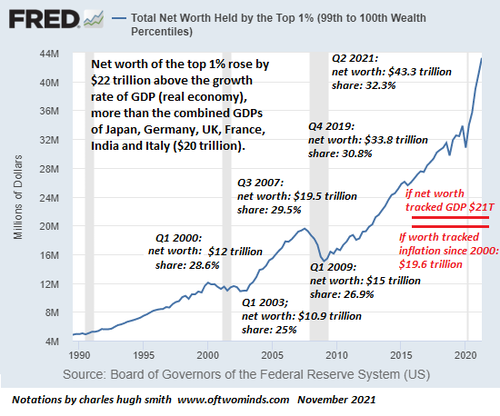Bulletin N° 1024
“Gandhi”
https://ww5.0123movie.net/movie/gandhi-11072.html
(3:11:15)
The film begins in the early part of the 20th
century, when Mohandas K. Gandhi (Ben Kingsley), a British-trained lawyer,
forsakes all worldly possessions to take up the cause of Indian independence.
Faced with armed resistance from the British government, Gandhi adopts a policy
of "passive resistance," endeavoring to win freedom for his people
without resorting to bloodshed. In the horrendous "slaughter"
sequence, more extras appear on screen than in any previous historical epic.
Subject: The Harvests of
Inequality.
February 10, 2022
Dear Colleagues and Friends of CEIMSA,
For a long time it has
been accepted as a truism by many people around the world that “war is
organized crime.” The mass slaughter in periods of war is undeniable, and these
crimes are rarely accounted for. But war by other means - as “diplomacy” is
sometimes called - has taken the on the same character. The deliberate
destruction of the Soviet Union, with financial manipulations that caused the
excess deaths of over 10 million people in the 1990s (according to United
Nations reports), is only one case which serves to exemplify this platitude.
Indeed, war is organized crime, and any contemporary understanding of the
central status of the world’s Military-Industrial Complex can easily lead us to
the following conclusion, that capitalism is organized crime.
The non-marxist, radical historian,
Barrington Moore, Jr. has illustrated this conclusion in his uncompromised
appraisal of the violence that has accompanied capitalist expansion over the
past centuries. In the sixth chapter of his comparative history, Social Origins of Dictatorship and Democracy: Lord and Peasant in the making of the Modern World (1966), the author turns to India, where the historic
absence of both a “bourgeois revolution” and a “peasant revolution” brought
about a unique democratic experience accompanied by a hidden violence that is hardly
called to our attention, but is none-the-less criminal. Moore adopts the
descriptive label for the “modern” capitalist system of India, “parasitic
capitalism,” which he describes as a chain of exploitative relationships that
extends beyond the poorest households, where the poor are living off the poorer.
The human degradation he
describes is matched only by the infinite capacity for metaphysical delusions,
in the form of ideologies which are endlessly promoted by the ruling classes.
The sixth chapter of
his radical comparative study is titled “Democracy in Asia: India and the Price
of Peaceful Change.” Here Moore tries to come to terms with the failure of the
capitalist revolution to penetrate the rural economy of India.
What is
the ultimate reason for this continuing stagnation and very halting progress,
we may legitimately ask, as we leave the village behind and strive to gain a
final perspective on the whole question. The proximate cause seems quite clearly
to be the relative failure of a market economy to penetrate very far into the
countryside and put the peasants into a new situation to which they seem quite
capable of responding with a sharp rise in output. The structure of village
society is only a secondary obstacle, one that changes in response external circumstances.
To concentrate on local resistances, to send endless teams of anthropologists
out to study the countryside, amounts to diverting attention from the main sources
of difficulty, the makers of government policy in Delhi. More about that in a moment.
Behind the weak push of the market lies the failure to channel into industrial
construction the resources that agriculture does generate. One further step,
taken with a glance at other countries, shows that the course of historical
development in India was such that no class grew up with any very strong
interest in rechanneling the agricultural surplus in such a way as to get the
process of industrial growth started. The Nationalist movement owed its popular
slogan to the peasantry and was, through Gandhi, suffused with its ideology.
This is
about as far as a sociological analysis can penetrate. My own strong suspicion
is that it already goes too far and that Nehru personally ought to bear a very large
share of the blame. Too great a concentration on circumstances and objective difficulties
leads to the mistake of forgetting that great political leaders are the ones
who accomplish important institutional changes despite such obstacles.
Nehru was a very powerful political leader. To deny that he had a great deal of
room to maneuver seems absurd. Yet on the most decisive question of all, his
policy was one of rhetoric and drift. The atmosphere of action became a substitute
for action. On this score at least, Indian democracy is not alone.
In
response to such an assessment, the Western liberal observer almost
automatically responds that even if Indian agrarian policy, indeed her economic
policy as a whole, has been rather long on talk and quite short on accomplishments,
at least there has not been brutality of communist modernization. Some sacrifice in speed, the argument
runs, is necessary for the sake for democracy.
This comfortable
generalization overlooks the dreadful costs in human suffering that a policy of
fesina lente imposes in the Indian situation. To measure these
costs in cold statistics is impossible. But a few figures will give a rough
notion of their magnitude. In 1924 and 1926 the all Indian Conference of
Medical Research Workers estimated that India suffered from five to six million
deaths a year from preventable diseases alone. After the famine of 1943, the
Bengal Famine Commission concluded that about a million and a half deaths
occurred ‘as a direct result of the Famine and the epidemics that followed in
its train. Though wartime disruption contributed to the tragic results,
fundamentally the famine was a product of the structure of Indian society. The
enormous death toll refers only to those who have fallen below the line that
separates success from failure in sheer biological survival. By themselves such
figures say nothing about the disease, squalor, filth, and brutish ignorance
perpetrated by religious beliefs among millions above the line. The upward
thrust of population means also that the threat of death on a massive scale
will hover in the background unless the rate of improvement rises sharply.
In
addition it is necessary to point out that if democracy means the opportunity
to play a meaningful part as a rational human being in determining one’s own
fate in life, democracy does not yet exist in the Indian countryside. The
Indian peasant has not yet acquired the material and intellectual prerequisites
for democratic society. The panchayat ‘revival,’ as I have indicated
earlier, is mainly romantic rhetoric. Actually the Community Development
Program has been imposed from above. Those who work in it have tended to shed
much of the romantic idealism, to conclude that democratic processes are ‘too
slow’ and to orient their behavior toward ‘results’ – often shallow statistical
ones such as the number of compost pits dug – that will satisfy their
superiors.
By
itself, the fact that the Program has been imposed from above is not bad. It is
the content of programs that matters. One can criticize bureaucratic leadership
in the abstract only from a conception of democracy that excluded any
interference whatever with the way human beings conduct their lives, no matter
how ignorant or how cruel these people are as a consequence of their history.
Anyone who holds this formalist conception of democracy would have to accept
the fact that large sections of the Indian peasantry do not want economic
development. They do not want it for reasons I have tried to explain. The only
consistent program, from this standpoint, would be to dismantle any program and
let the Indian peasants wallow in filth and disease until they starved. The results
are scarcely likely to please any kind of democratic theorist.
More
realistic policies might be grouped around the kinds of interference used and
the costs of using one kind versus another. Whether any particular one will be
adopted or none, with the Indian state breaking up along its present lines of
cleavage, is another kind of question I do not propose to discuss.
If the
prevailing policy in its essential outlines continues , as far as can be
foreseen it should result in a very slow rate of improvement, mainly through
the action of the top stratum of the peasantry continuing to go over to peasant
forms of commercial farming. The danger has already been pointed out: the
steady swelling of an urban and rural proletariat on an ever larger scale. This
policy could in time perhaps generate its own antithesis, though the difficulties
of a radical takeover in India are enormous.
Much more
desirable from a democratic standpoint could be for the government to harness
and use these same tendencies for its own purposes. That would mean discarding
the Gandhian doctrines (perhaps not so unlikely in the new administrative generation
now coming to power), allowing the upper strata in the countryside free rein,
but taxing their profits and organizing the market and credit mechanism in such
a way as to drive out the moneylender. If the government in this way succeeded
in tapping the present surplus generated in agriculture and encouraging the
growth of much bigger one, it could do a great deal more about industry on its
own resources. As industry grew, it would sop up much of the surplus labor
released in the countryside and spread the market ever more rapidly in a
continually accelerating process. The efforts to bring technology and modern
resources to the peasant’s doorstep would then bear fruit.
The third
possibility would be to go over to much wider use of compulsion, more or less
approaching the communist model. Even if it could be tried in India, it seems
highly unlikely that it should work. Under Indian conditions for a long time to
come, no political leadership – no matter how intelligent, dedicated, and
ruthless – could, it seems to me, put through a revolutionary agrarian policy.
The country is too diverse and too amorphous still, though that will gradually
change. The administrative and political problems of forcing through a
collectivization program against the barriers of cast and tradition in
fourteenth languages seems too formidable to require further discussion.
Only one
line of policy then seems to offer real hope, which to repeat, implies no prediction
that it will be the one adopted. In any case, a strong element of coercion
remains necessary if a change is to be made. Barring some technical miracle
that will enable every Indian peasant to grow abundant food in a glass of water
or a bowl of sand, labor will have to be applied much more effectively,
technical advances introduced, and means found to get food to the dwellers in
the cities. Either masked coercion on a massive scale, as in the capitalist
model including even Japan, or more direct coercion approaching the socialist
model will remain necessary. The tragic fact of the matter is that the poor
bear the heaviest costs of modernization under both socialist and capitalist
auspices. The only justification for imposing the costs is that they would
become steadily worse off without it. As the situation stands, the dilemma is
indeed a cruel one. It is possible to have the greatest sympathy for those
responsible for facing it. To deny that it exists is, on the other hand, the
acme of both intellectual and political irresponsibility. (pp.406-410)
Moore bases his dire conclusions about Indian
society on an analysis of the historic origins of limitations on the political
economy in this region of the world. He begins this study with the following observations:
Relevance
of the Indian Experience.
That
India belongs to two worlds is a familiar platitude that happens to be true.
Economically it remains in the preindustrial age. It has not had an industrial
revolution in either of the two capitalist variants discussed so far, nor according
to the communist one. There has been no bourgeois revolution, no conservative
revolution from above, no peasant revolution. But as a political species it
does belong to the modern world. At the time of Nehru’s death in 1964 political
democracy had existed for seventeen years. If imperfect, the democracy was no
mere sham. There had been a working parliamentary system since Independence in
1947, an independent judiciary, and the standard liberal freedoms: free general
elections in which the governing party had accepted defeat in an important part
of the country, civilian control over the military, a head of state that made
very limited use of formal extensive powers. There is a paradox here, but only
a superficial one. Political democracy may seem strange in both an Asian
setting and one without an industrial revolution until one realizes that the
appalling problems facing the Indian government are du to these very facts.
. . .
There were . . . powerful obstacles to modernization
present in the character of Indian society prior to the British conquest.
Others came to the surface as a result of this conquest. Others came to the
surface as a result of this conquest. During the late eighteenth and the first part
of the nineteenth centuries, the British introduced new systems of taxation and
land tenure, as well as textiles that may have damaged artisan castes. The
British further made visible the whole apparatus of Western scientific culture
that was a threat to traditional priestly privilege. The response was the
Mutiny of 1857, a reactionary convulsion and unsuccessful effort to expel the British.
A deeper and more long-run effect of the introduction of law and order and and
taxes, and of an increasing population, was the rise of parasitic landlordism.
Despite poor cultivation, the peasant did generate a substantial economic
surplus. The British presence, the failure of the Mutiny, the character of
Indian society ruled out the Japanese solution to backwardness: rule by a new
section of the native élite which used this surplus as the basis for industrial
growth. Instead, in India the foreign conqueror, the landlord, and the
moneylender absorbed and dissipated this surplus. Hence economic stagnation continued
throughout the British era and indeed into the present day.
On the other hand, the British presence prevented
the formulation of the characteristic reactionary coalition of landed élite
with a weak bourgeoisie and thereby, along with British cultural influences,
made an important contribution toward political democracy. British authority
rested heavily on the landed upper classes. The native bourgeoisie, especially
the manufacturers, on the other hand felt cramped by British policies, particularly on free trade,
and sought to exploit a protected Indian market. As the nationalist movement grew
and looked for a mass basis, Gandhi provided a link between powerful sections
of the bourgeoisie and the peasantry through the doctrine of nonviolence,
trusteeship, and the glorification of the Indian village community. For this
and other reasons, the nationalist movement did not take a revolutionary form,
though civil disobedience forced the withdrawal of the weakened British empire.
The outcome of these forces was indeed political democracy, but a democracy
that has not done a great deal toward modernizing India’s social structure.
Hence famine still lurks in the background.(pp.314-316)
Mogul
India: Obstacles to Democracy.
The last
of the many conqueror’s that invaded India before the Western impact were the
Moguls, a name applied to one large segment of the followers of the great
Mongol leader, Genghis Khan. Early in the sixteenth century the first of their leaders
invaded India. They reached the height of their power under Akbar (1556-1605),
a contemporary of Queen Elisabeth I, though subsequent rulers did extend the
territory under their control. By the end of the sixteenth century, an
appropriate starting point for out account, this Islamic dynasty controlled the
lion’s share of India, approximately down the peninsula to a line running east
and west somewhat north of Bombay. Hindu
kingdoms to the south remained independent. As the Moguls adapted their rule to
Hindu circumstances, there was little difference between them, beyond the fact
that, at its best, the Mogul territory was better governed.
According
to a well-known description, the fundamental features of the traditional Indian
polity were a sovereign who ruled, an army that supported the throne, and a peasantry
that paid for both. To this trio one must add, for an adequate comprehension of
Indian society, the notion of cast. For the moment we my describe the cast
system as the organization of the population into hereditary and endogamous groups
in which the males perform the same type of social function, such as that of
priest, warrior, artisan, cultivator, and the like. Religious notions of
pollution sanction this division of society into theoretically watertight and
hierarchically ordered compartments. Cast served, and still serves, to organize
the life of the village community, the basic cell of Indian society and the
fundamental unit into which it tended to disintegrate wherever and whenever a
strong ruler was lacking.
This institutional
complex of village communities organized by cast, supporting by their taxes an
army that was the main prop of the ruler, has proved to be a hardy one. It
characterized the Indian polity throughout the British period. Even under Independence
and Nehru, much of the Mogul system has remained intact.
Essentially
the political and social system of the Mogul was an agrarian bureaucracy,
imposed on top of a heterogeneous collection of naive chieftains differing widely
in resources and power. As Mogul authority weakened in the eighteenth century,
it reverted to looser forms. Under Akbar and succeeding strong rulers, there
was no landed aristoctacy of national scope independent of the crown, at least
not in theory and to a considerable extent not in fact.(pp.317-318)
. . .
In
general, the attitude of the political authorities in India toward the merchant
seems to have been closer to that of the
spider toward the fly than that of the cowherd toward his cow that was
widespread in Europe at the same time. Not even Akbar, the most enlightened of
the Moguls, had a Colbert. In the Hindu areas the situation was probably
somewhat worse. Local authorizes, such as the governor of a town, might at
times take a different view, though they too were under pressure to make and
spend their fortunes rapidly. All in all, I believe it safe to conclude that
the establishment of peace and order (of a sort) did not create a situation in
which the”rise of mercantile influences could undermine the agrarian order to the
extent that it did in Japan. The Mogul system was too predatory for that; not because
its rulers and officers were necessarily more vicious as human beings (though
some of the later rulers were drug sodden and bloodthirsty, perhaps out of
boredom and hopelessness), but because the system put the ruler and his servants
in a situation where greedy behavior was often the only kind that made
sense.(pp.323-324)
. . .
As one
looks back over the record, it is easy to conclude – perhaps a trifle too easy
– that the dynamics of the Mogul system were unfavorable to the development of
either political democracy or economic growth in anything resembling the
Western pattern. There was no landed aristocracy that had succeeded in achieving
independence and privilege against the monarch while retaining political unity.
Instead their independence, if it can be called that, had brought anarchy in
its train. What there was of a bourgeoisie likewise lacked an independent base.
Both features are connected with a predatory bureaucracy, driven to become ever
more grasping as its power weakened, and which by crushing the peasants and
driving them into rebellion returned the subcontinent to what it had often been
before, a series of fragmented units fighting with one another, ready prey for
another foreign conqueror. (pp.329-330)
Village
Society: Obstacles to Rebellion.
The character
of the upper classes and political institutions have suggested some reasons why
there was not in India the kind of economic and political movement toward capitalism
and political democracy that parts of Europe displayed from the sixteenth to
the eighteenth centuries. A closer look at the place of the peasants in Indian society
will help to account for two further features that have been of the utmost importance:
widespread poor cultivation, which contrasts in the sharpest possible manner
with the gardenlike peasant agriculture in China and Japan, and the apparent political
docility of the Indian peasants. Though there were exceptions to this docility,
best discussed in a separate section, peasant rebellions never assumed remotely
the same significance in India that they did in China.
Crops and
ways of growing them were very much the same in Akbar’s time as they still are
today over wide sections of India. Rice was prominent in Bengal. Northern India
in general grew cereals, millets and pulses.
. . . It is often claimed that the unpredictability of natural forces
has made the Indian peasant passive and apathetic and prevented the transition to
intensive peasant cultivation. I doubt this very much. China has been as much
subject to intermittent famine as India, yet her peasants are universally recognized
for their energy and careful cultivation from quite early times.
By
contrast, Indian practices appear wasteful and inefficient, even if one makes
considerable allowance for ethnocentric bias in the early British accounts.
Technology too seems to have been stagnant. Agricultural implements and techniques
did not change significantly between Akbar’s time and the early twentieth century.
A light plow, drawn by bullocks, was and remains today the most important implement.
The cow has thus been a source of power, of food (not of course meat), and fuel,
as well as an object of religious veneration. The advantages of transplanting
rice were known, at least in some areas, in the early part of the nineteenth century
and very likely earlier. But, in contrast with Japan, the organization of the
work was so poor that the cultivators obtained only limited benefits. ‘About
half of the whole [crop] is finally transplanted in the first month of the
season,’ Buchanan reported in 1809-1810 for one district in the northeast
corner of Bengal, ‘and is extremely productive; five-eighths of the rest are transplanted
in the second month and give an indifferent crop; and three-eighths are transplanted
in third month, making so miserable a return that the practice would seem to be
bad economy, but the people would otherwise be idle.
Buchanan,
one of the few sources to give details on agricultural practices at this time,
also tells us that, instead of rotating crops, the cultivator’s in this
district often mixed several crops on the same field. This was a crude form of insurance;
though none of the cops grew well, seldom did all of them fail. In another
district on the banks of the Ganges it was common practice, again in sharp
contrast with Japan, to sow large quantities of seed broadcast on dry earth
without previous preparation of the soil, a practice he also noticed in the
area just mentioned. Throughout Bucanan’s reports there runs the same theme of
inefficient cultivation and low productivity that occurs in the earlier French accounts
of the situation under the Moguls.
It is
quite possible that the relative abundance of land may have been an important
cause of both poor cultivation and the character of peasant opposition through
much of Indian history prior to the British. Land in many places was plentiful
and waiting for men with resources to cultivate it. Peasants, as we saw, often
responded to an oppressive ruler’ simply by absconding en masses. In the words
of a recent authority flight was ‘the first answer to famine or man’s
oppression.’ Oppression and abundance of land interacting with each other in this
way account quite well for the wide areas of uncultivated and badly cultivated
land that occur very frequently in the accounts of late Mogul and early British
times. (pp.330-332)
Another factor which
explains the historic inefficiency of Indian agriculture, according to
Barrington Moore, is the traditional system of taxation.
Like his counterpart in Japan, the Indian peasant
was to the ruling classes mainly a producer of revenue. The Japanese tax, we saw,
was a fixed assessment on the land, enabling energetic peasants to keep a
surplus. Mogul and Indian taxation was mainly a fixed proportion of the crop. Thus
in India the more the peasant grew, the more he had to turn over to the tax
collector. Furthermore the Mogul system of tax farming contained a built-in
temptation to squeeze the peasants heavily. Very likely this difference had a
decisive influence on the character of the peasantry in the two counties.
. . .
The
organization of labor in the Indian peasant community also differed from that
in Japan in a manner that helps to explain the relatively low level of
cultivation. Here we encounter directly the cast system, which will shortly require
fuller discussion. For the moment it is enough to recall that the Japanese
system before it began to change in late Tokugawa times was based mainly on pseudokinship
ties. The Indian one was based instead on the exchange of labor and services of
food between castes who had land and those who had little or none. Though
closer to the modern system of hired labor, the Indian arrangement too was
supported by custom and what we can loosely call traditional sentiments. It appears
to have had some of the disadvantages of both customary systems based on
emotional loyalties and modern ones without their respective advantages, and to
have inhibited both changes in the division of labor and its intensive
application to a specific task. On account of the flexibility of caste in actual
practice, it should be unwise to press this point too far, though the tendency
seems clear. Close supervision in the modern fashion was difficult. So was the cooperation
found in many tightly knit traditional work groups. Most Indian laborers were
at the very bottom of the cast system and in large measure excluded from the village
community, as shown by the designation ‘untouchable.’ Strikes of the modern
sort, the untouchables scarcely knew, partly because laborers were broken up
into different casts, but ‘dilution of labor
they understood,’ as a modern authority puts it. This was one of the reasons
for lackadaisical cultivation. Another was the fact that higher castes often preferred
smaller returns, with less trouble and supervision, to standing over workers and
trying to compel them to improve their ways.
A few
word of caution are in order before going further into the question of caste
and its political implications. At least in its full ramifications, the caste
system is unique to Indian civilization. For this reason there is a strong
temptation to use caste as an explanation for everything else that seems
distinctive in Indian society. Obviously this will not do. For example, caste
in older studies has been used to explain the apparent absence of religious warfare
in India. Yet in modern times – not to mention Hindu resistance to Moslem
proselytism in earlier days – religious warfare has taken on terrible
proportions while caste has remained. Caste, and the theory of reincarnation,
which forms an important part of caste doctrines, has also been used to explain
the apparent political docility of the Indian peasants, the feebleness of the
revolutionary upsurge in modern times. Yet we have seen that this upsurge was
an important component of the forces that bought down the Mogul edifice. Nor is
it altogether absent in later days. Still the overall evidence of
submissiveness remains overwhelming. That caste has played a part in creating
and supporting this behavior I see no sense in denying. Rather, the problem is
to understand the mechanisms that produced passive acceptance.
The
standard explanation, runs about as follows. According to the theory of
reincarnation, a person who obeyed the requirements of caste etiquette in his life
would be born into a higher caste in the next. Submissiveness in this life was
to be rewarded by a rise in the social scale in the next. This explanation required
us to believe that the ordinary Indian pedant accepted the rationalizations put
forth by urban priestly classes. Perhaps the Brahmans did succeed in this way
to some extent. But it can only be a small part of the story. As far as it is
possible to recover the attitude of the peasants toward the Brahman, it is
fairly clear that the peasants did not passively and wholeheartedly accept the
Brahman as a model of all that was good and desirable. Their attitude toward
the monopolist of supernatural power seems to have been a mixture of admiration,
fear, and hostility, much like that of many French peasants toward the Catholic
priests. ‘There are three blood suckers in this world,’ runs a North Indian
proverb, ‘the flea, the bug and the Brahman.’ Since the Brahman exacted payment
for his services to the village, there were good reasons for this hostility.
‘The farmer does not reap his harvest without paying the Brahman to perform
some ceremony; a tradesman cannot begin a business without a fee to a Brahman,
a fisherman cannot build a new boat nor begin to fish . . . without a ceremony
and a fee. Secular sanctions were obviously part of the caste system. And in a
general way we know that human attitudes and beliefs fail to persist unless the
situations and sanctions that reproduce them continue to persist or, more
crassly, unless people get something out of them. To these concrete supports we
must obviously turn if we are to understand caste.
The first
of these was and remains the ownership of land. The universal superiority of
the Brahman is a priestly fiction that does not correspond to the workings of
the caste system now and probably has not done so for ages. In modern villages
the economically dominant group is also the dominant caste. In one village it
may be the Bahaman, in another a peasant caste. Even where the Brahmans are on
top, it is because of their economic function , not their priestly one. Thus we
see that caste has had and still has an economic base and a religious
explanation and that the fit between the two has for long been far from perfect.
The caste that holds the land in a particular locality – the caste is a reality
only in this local manifestation – is the highest caste. To argue backward from
a modern situation is, of course not altogether safe. Before British influence
made itself felt very widely and when land was in present-day terms abundant,
the economic basis was perhaps less crassly obvious. Nevertheless it was there.
The evidence is clear, even for earlier times, that the higher castes often
held the best land and could command the labor of the lower castes.
The main
formal instrument for the enforcement of caste regulations was and remains the caste
councils, composed of a small group of leaders chosen from the members of each
caste in all of the villages inhabiting a certain area. In some parts of India
one finds a hierarchy of these councils. The council controls only the behavior
of the members of its own caste.
. . .
Caste manifests itself strictly on the local level.
Even in the village there is really no central organization with the task of
seeing to it that the caste system as such remains in force, i.e., that members
of lower castes display the proper deference toward members of the higher ones.
The lower castes disciplined themselves. Members of the lower castes had to
learn to accept their place in the social order. On this score, the leaders of
the lower castes evidently had an important task to perform. For doing so they
received quite concrete rewards. Sometimes they received commissions on the
wages of laborers from their castes as well as fines from any transgressions of
caste regulations.
The penalty
for sever breaches of caste discipline was boycott, that is, denial of the
facilities of the village community. In a society where the individual depended
almost entirely on these facilities, the organized pattern of cooperation among
his fellows, such a penalty was terrible indeed. In due course we shall see how
the advent of the modern world has partly mitigated the impact of these sanctions.
What exactly
did this system enforce? Quite obviously a local division of labor and a
corresponding distribution of authority and power. But it evidently did a great
deal more than this. In pre-British Indian society, and still today in much of
the countryside, the fact of being born in a particular caste determined for
the individual the entire span of existence, quite literally from before
conception until after death. It gave the range of choice for a marital partner
in the case of parents, the type of upbringing the offspring would have and
their choice of mate in marriage, the work he or she could legitimately
undertake, the appropriate religious ceremonies, food, dress, rules of evacuation
(which were very important), down to most details of daily living, all
organized around a conception of disgust.
Without
this universal supervision and indoctrination it is difficult to imagine how
and why the lower castes would accept caste in a way that would make it work without
more centrally organized sanctions. It seems to me that its diffuseness and the
fact that it extended beyond the areas Westerners consider to be economic and political,
even in a broad and loose sense, constituted the essence of caste. Human beings
in a wide variety of civilizations have an observable tendency to establish
‘artificial’ distinctions, that is, those that are not derived from the
necessities of a rational division of labor or a rational organization of
authority, using rational here in the very restricted sense of providing effective
social mechanism for performing an immediately given task in such a way as to
enable the group to survive. Children elaborate artificial distinctions all the
time in Western society. So do aristocrats when freed from the necessities of
ruling. Indeed the need to perform a particular task may break down artificial
distinctions: military etiquette in the field is generally much less elaborate than
it is at headquarters. The reason for this tendency toward snobbishness –
highly developed in some of the most ‘primitive’ societies – is not easy to
perceive. Though I cannot prove it, I suspect that one of the few lasting and
dependable sources of human satisfaction is making other people suffer and that
this constitutes the ultimate cause.
Whatever
the origins may be, the fact that in India caste served to organize so wide a
range of human activities has had, I would urge, profound political consequences.
As a system that arranges life effectively in a specific locality, caste spells
indifference to national politics. Government above the village was an excrescence
generally imposed by an outsider, not a necessity, something to be borne with
patience, not something to be changed when the world is obviously out of joint.
Because it had really nothing to do in the village where caste took care of everything,
government may have seemed especially predatory. The government was not
necessary to keep order. Its role in the maintenance of irrigation systems,
pace Marx, was quite minor. Again these were often quite local affairs. The structural
contrast with China is quite striking. There the imperial bureaucracy gave
cohesion to the society and was what had to be changed when the villagers suffered
prolonged disaster. Even so, to put the contrast that way remains on the
surface. In China the local gentry needed the imperial bureaucracy as a
mechanism for obtaining the economic surpluses out of the peasantry that supported
their position locally and nationally. At the local level such an arrangement
was unnecessary in India. Caste regulations took its place. Where he exited,
the zamindar had won an accepted place in the local scheme of things. He
did not need the central government to help him extract his perquisites from
the peasantry. Thus the character of the two systems meant that peasant
opposition would take different forms in each. In China the main thrust was to
replace a ‘bad’ government by a ‘good’ one of the same character; in India it
was much more toward getting rid of government above the villages altogether.
And in India for the most part we can scarcely speak of a strong thrust in any sense
but, rather, a general direction to affairs imposed by the character of the society.
By and large, government was more superfluous than actively resisted, though at
times resistance occurred as well.
Because caste
has embraced such a wide range of human behavior, there has also been a strong
tendency in Indian society for opposition to the prevailing order to take the form
of just another caste. It appears quite strikingly in the case of the criminal
castes notably the Thugs from whom the English word has come, which were so troublesome
to the British in the first half of the nineteenth century. Similarly since
caste was expressed very heavily in religious ritual, opposition to the
oppressive features of caste was likely to be absorbed into the system in the
form of an additional caste. Partly this was true because there was not
religious hierarchy comparable to the Roman Catholicism, indeed no very specific
orthodoxy that could present a specific target. Thus caste was and indeed
remains tremendously persistent and tremendously flexible, in its concrete
manifestation, a huge mass of locally coordinated social cells that tolerate
novelty by generating another cell. This was the fate that awaited foreign
conquerors as in the case of Islam, and even of Europeans. These too became to
all intents and purposes a separate caste, though their rating on the scale of
disgust was opposite to that of the
scale of political power. Somewhere I have read that good Hindus in early
British times always used to take a thorough bath to wash away pollution after having
dealings with an Englishman.
Opposition to the hierarchical system as such, however, was relatively
rare even in a veiled form. Much more frequently in British times and very likely earlier has been the
attempt by the caste as a whole to struggle up to a higher rung on the ladder
of esteem and disgust by persuading its members to adopt the proper (i.e. Brahman)
diet, occupation, and martial practices. To be able to burn widows was a
decisive sign that a caste had arrived socially. By providing a form of
collective upward mobility that required strict discipline and adherence to
norms set by the upper castes. Indian society further limited the possibility
of political opposition. Thus the system emphasized the individual’s duty to caste,
not individual rights against society. What rights there were against society
tended to be group rights , those of the caste. In the willing acceptance of
personal degradation by its victims and the absence of a specific target for
hostility, a specific locus of responsibility for misery, the Indian caste
system strikes a modern Westerner as a curiously intensified caricature of the
world as Kafka saw it. To some extent these negative features may be the
consequence of distortions introduced into Hindu society by the British occupation.
Even if this is so, it is a distortion of features that were present before the
British ever appeared, and their character is no small part of the cause of
subsequent misery.
To sum
up, at least provisionally and very tentatively, I would suggest that, as an
organization of labor, caste in the countryside was a cause of poor
cultivation, though certainly not the only one. Furthermore, as the
organization of authority in the local community, caste seems much more clearly
to have inhibited political unity. By its very flexibility Indian society seems
to have rendered fundamental change very difficult. Still, it was not
impossible. Indeed the new conquerors that replaced the Moguls were to plant
seeds whose fruit neither they not others could have guessed.(pp.332-341)
Changes
Produced by the British up to 1857.
One
cannot discuss the impact of the British or Indian society as if it were the
result of a uniform cause operating continuously over more than three
centuries. British society and the character of the British who went to India
changed enormously between Elizabethan times and the twentieth century. Some of
the most significant alterations took place roughly during the century
1750-1850. In the middle of the eighteenth century the British were still
organized for commerce and plunder in the Honorable East India Company and
controlled no more than a small fraction of Indian territory. By the middle of
the nineteenth century they had become in effect the rulers of India, organized
in a bureaucracy proud of its tradition
of justice and fair dealing. From the
standpoint of modern sociological theories of bureaucracy, it is almost
impossible to see how the change could have taken place since the historical
raw materials were so unpromising: a company of merchants not too easily distinguished
from pirates on the one hand, and a series of decaying Oriental despotisms on
the other. One may legitimately press the sociological and historical paradox
even further: from this equally unpromising amalgam there eventually emerged a
state with valid claims to democracy!
. . .
Three interrelated consequences for Indian society
followed: the beginnings of an abortive commercialization of agriculture
through the establishment of law and order, regular taxes, and property in the
countryside; secondly, the partial destruction of rural handicrafts; and
finally, an unsuccessful attempt to throw off the British yoke in the Mutiny of
1857. In turn these three processes set the basic framework for what has taken
place down to the present day.( pp.341-343)
. . .
At bottom the Mutiny was an attempt to restore an
idealized status quo that supposedly existed before the British
conquest. In this sense it was an out-and-out reactionary upheaval. The fact
that it attracted widespread support form the population seems to contradict
such an assessment but, instead, under the conditions of the times, reinforces
it.
With the English
present as conquerors and the main carriers of the new civilization, it is
difficult to see how the Mutiny could have been anything else. Its failure
ruled out for India any prospect of developing along Japanese lines. In any case
such a prospect was so remote that it scarcely deserves serious consideration.
This is not because the foreigner had such a strong foothold. That the English
might have been driven out does not seem foolish. The crux of the matter is
that, in the Indian situation, the foreign presence imposed a reactionary
solution. India was too divided, too amorphous, and too big to be unified on
its own under dissident aristocratic auspices, with some help from the peasants,
as happened in Japan. Over long centuries a society had grown up that rendered central
authority in substantial measure superfluous, perhaps inherently predatory and
parasitic. In the Indian situation, around the middle of the nineteenth century,
dissident aristocrats and peasants could work together only through passionate
hatred of modernization. They could not, as in Japan, use modernization to
drive the foreigner away. Ninety more years were to pass before the British
were to be driven out. Though new factors entered the situation in the
meantime, the reactionary component in the effort to drive them out remained very
powerful, enough to handicap very seriously subsequent efforts at becoming an
industrial society.(pp.352-353)
Sincerely,
Francis McCollum Feeley
--
Professeur honoraire de l'Université
Grenoble-Alpes
Ancien Directeur des Researches
Université de Paris-Nanterre
Director of The Center for the Advanced Study
of American Institutions and Social Movements
(CEIMSA-in-Exile)
The University of California-San Diego
http://www.ceimsa.org
a.
Top
1% Gains More Wealth Than GDPs Of Japan, Germany, UK, France, India, &
Italy Combined; Bottom 50% - You Get Nothing

by Charles Hugh Smith via OfTwoMinds
blog,
Wealth inequality easily falls into
an abstraction unless we contextualize it in meaningful ways. I've annotated two St. Louis Federal Reserve (FRED)
charts--the net worth of America's top 1% and the net worth of America's bottom
50% of households, roughly 66 million households--to show their net worth and
their share of all household net worth, and put this in the context of
inflation and GDP (gross domestic product) of the U.S. and other nations.
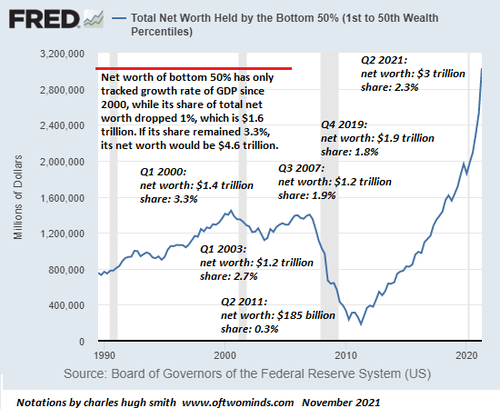
These charts may look complicated but the idea is actually pretty simple: I've
noted how each group (the top 1% and the bottom 50%) did at the top and bottom
of each bubble: the dot-com bubble in 2000, the stock/housing bubble that
topped in 2007, and the current bubble, noting the pre-pandemic data at the end
of 2019 and the most recent totals (2nd quarter 2021).
Next, I pose a simple question: if the net worth of each group had tracked
the growth of America's GDP (i.e. its real economy), where would its net worth
be now? All else being equal, the assumption that net worth would rise
more or less in lockstep with the expansion of the entire economy makes sense.
I note both the dollar amount of each group's net worth and their share of
total household wealth to track their slice of wealth relative to the entire
pie of wealth and to each other's slice. In other words, as the net
worth pie expands, does each group expand its share of the pie or not?
What we find is a stunning asymmetry: if the top 1%'s net worth has
risen along with GDP since 2000, it would now be about $21 trillion. Instead,
it's now over $43 trillion, a $22 trillion gain above where it would be had it
tracked GDP growth.
For context, this is larger than the GDP of the U.S. ($21 trillion) and the
combined GDPs of the six largest economies behind the U.S. and China: Japan,
Germany, UK, France, India and Italy which total about $20 trillion. It's more
than the nominal GDPs of China and Japan.
In other words, the $22 trillion gained by America's top 1% as a result of
Federal Reserve bubble-blowing is literally beyond comprehension: s
sum larger than entire economies, a sum totally disconnected from America's
real-world economic expansion.
Note that the top 1%'s share of total wealth has increased with every
bubble: even as the pie of wealth expanded, the top 1%'s share has
increased to roughly one-third of all wealth, which includes vehicles, homes,
financial assets, etc. (The top 1% owns the majority of all financial assets.)
In comparison, the bottom 50%, despite recent gains resulting from the
housing bubble, has only tracked GDP: where the top 1% more than
doubled its wealth above where it would have been had it risen along with GDP,
the bottom 50% have barely kept up with GDP's expansion. If it wasn't for the
current housing bubble, the bottom 50%'s wealth wouldn't even have kept up with
GDP.
The bottom 50% has lost ground in terms of its share of total household net
worth: its already-marginal 3.3% of total wealth in 2000 has slipped
to an inconsequential (i.e. signal-noise) 2.3%.
If the bottom 50% had maintained its meager 3.3% share, its net worth would be
higher by $1.6 trillion--1% of the total net worth of U.S. households ($160
trillion). That's 50% higher than its current net worth of $3 trillion.
Note how the housing bubble bursting in 2008-09 basically destroyed the
wealth of the bottom 50% whose primary asset (if any) is a home. Net
worth of the bottom 50%--over 60 million households-- fell to a near-zero $185
billion in 2011 at the nadir of the housing market.
The top 1%'s fortunes have climbed in a series of higher lows and much
higher highs: each spot of bother (collapse of the bubble du jour)
dented the net worth of the top 1%, but their wealth never even declined to
previous troughs. At the bottom of the oh-so horrendous market drop in 2020,
the top 1%'s wealth was still double what it had been at the trough in 2009,
$30 trillion vs. $15 trillion.
_1.jpg?itok=j6SnyzJv)
All of this upward shift of wealth accelerates as we approach the apex of
wealth-power: a handful of billionaires own more than the bottom 50%
(by some measures, the asymmetry is even worse than depicted by FRED data.)
Given that political power in America is a pay-to-play auction in
which the highest bidder wins, how this incomprehensibly lopsided ownership
of wealth plays out is an open question. The pendulum of wealth-power
concentration has reached an extreme, and when it swings back, it will reach an
equally extreme position at the other end of the spectrum.
+
Daniel
Korski: The Intelligence-Linked Mastermind Behind the UK’s Orwellian Healthtech
Advisory Board
https://unlimitedhangout.com/2020/10/investigative-reports/korski/
by Johnny Vedmore
For
those who are not so familiar with 18th century social philosophy, a Panopticon was
originally the design of a prison building by an English philosopher
named Jeremy Bentham. The Panopticon
prison’s architecture would allow one guard in a central guard tower to observe
every inmate without those prisoners knowing that they were being observed, and
so those incarcerated were left to assume that they were actually being
observed all of the time. This prison would, in theory, allow that singular
guard to maintain order over every inmate.
Much
later, in the 20th century, the famous French philosopher, Michel Foucault, would use the
concept of Bentham’s original Panopticon as a way to describe and explore
“disciplinary power”. According to Foucault’s work, disciplinary power had been
successful due to its utilisation of three technologies; hierarchical
observation; normalising judgment; and examinations. Hierarchical observation
refers to the fact that the observer in a Panopticon can be of any hierarchical
position within the observing body, meaning that a prison guard, supervisor, or
a governor could be the person viewing the inmates. Foucault would also insist
that the normalisation of judgement is imperative for disciplinary power to
exist. The final principle, the examination, is used to combine the first two
principles of the observations and the resulting judgements to help decide on
whether further actions should be taken or punitive measures be applied.
Among
the most notable of Foucault’s analyses of the utility of the Panopticon is the
following quote from his book Discipline
and Punish: “The major effect of the panopticon is to induce in the
inmate a state of consciousness and permanent visibility that assures the
automatic functioning of power.” In other words, the uncertainty of whether or
not an individual is being constantly watched induces obedience in that
individual, allowing only a few to control the many.
===========
b.
Wall
Street’s Takeover of Nature Advances with Launch of New Asset Class

by Whitney Webb
(October 2021)
+
Erik Prince
helped raise money for effort to spy on progressives and anti-Trump Republicans
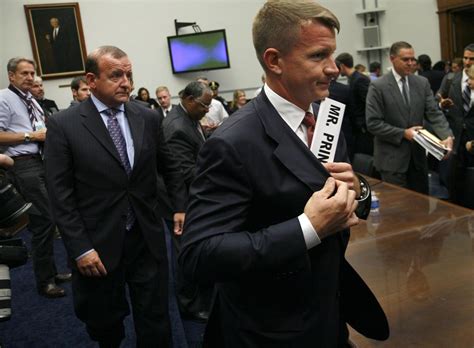
by Mychael Schnell
+
Chris
Hedges and Louis Hyman on the Harmful Gig Economy
https://scheerpost.com/2022/02/06/chris-hedges-and-louis-hyman-on-the-harmful-gig-economy/
with Chris Hedges
(26:18)
+
The
Warmongers Miscalculated
https://scheerpost.com/2022/02/06/the-warmongers-miscalculated/
by David Swanson
+
Ralph
Nader on Facilitating Civic and Political Energies for the Common Good

by Ralp Hader
+
The Antiwar
Movement That Wasn’t Enough

https://scheerpost.com/2022/02/07/the-antiwar-movement-that-wasnt-enough/
by Nan Levinson
+
European
Electricity Prices Soar After France Cuts Nuclear Output Forecast
by Tyler Durden
===========
c.
de : News
from Underground
envoyé : 5
février 2022
objet : Daily digest for nfu@simplelists.com
|
1.Djokovic decides to get "vaccinated" after all - Mark
Crispin Miller (03 Feb 2022 20:36 EST) |
|
2.Pharma liability shields at risk if courts find FRAUD - Mark
Crispin Miller (04 Feb 2022 13:56 EST) |
|
3.Dr. McCullough invites anyone who thinks he's wrong, and
knows enough to say so, to debate him - Mark
Crispin Miller (04 Feb 2022 16:18 EST) |
|
4.New
Yorkers, we have to STOP this! Hochul's trying to give herself a permanent
new power to mandate masks (for the "unvaccinated") - Mark
Crispin Miller (04 Feb 2022 16:23 EST) |
|
5.Ten pieces of good news this week (unless you're
"woke") - Mark Crispin Miller (04 Feb 2022 16:32
EST) |
|
6."Time in nature can now be prescribed as health care
treatment in Canada" - Mark Crispin Miller (04
Feb 2022 17:27 EST) |
|
7.Premier of Alberta (who's NOT in hiding) says his
government will CANCEL "vaccine" passport - Mark
Crispin Miller (04 Feb 2022 17:30 EST) |
1.Djokovic
decides to get "vaccinated" after all by Mark
Crispin Miller (03 Feb 2022 20:36 EST)
Reply
to list
Does he think Nadal won because of
the jab?
Tennis
Djokovic to get vaccinated against
COVID-19 following Nadal's Australian Open victory
https://amp.marca.com/en/tennis/2022/02/02/61fa8932e2704e492e8b45bd.html
The
Serbian missed the tournament after he was deported
Novak Djokovic in Serbia.
JOAN SOLSONA
Adapted by Nigel Chiu
Actualizado 02/02/2022 14:46 CET
Compartir en
Facebook
Compartir en
Twitter
Compartir en Whatsapp
TennisDjokovic
praises Nadal's 'impressive fighting spirit'
TennisMcEnroe:
I'd like the Big Three to end up with same number of Slams
Novak
Djokovic has chosen to be vaccinated against COVID-19, according to his
biographer Daniel Muksch.
The
men's world number one missed the Australian Open, which was won by Rafa Nadal, after a controversial
saga which saw him twice appeal a decision that prevented him to play in the
tournament, only to be deported.
Nadal's
victory made him statistically the greatest men's tennis player of all time
with 21 Grand Slams, one more than Djokovic and Roger Federer.
2.Pharma
liability shields at risk if courts find FRAUD by Mark
Crispin Miller (04 Feb 2022 13:56 EST)
Reply
to list
BY PATRICIA
HARRITY ON JANUARY
31, 2022
If
Pfizer and the FDA do not release the data on their clinical trials, former
Blackrock & Hedge Fund Guru Edward Dowd says he is assuming fraud,
and Fraud Eviscerates all
Contracts,
that’s case-law.
Dowd
says that big pharma is supposed to be one of the most regulated industries,
particularly with the Food and drug administration (FDA) however, after touting
that the jabs are safe and also effective, their blanket immunity from
liability may no longer apply if fraud is found to have occurred.
This
could be game over for companies such as Moderna and other mRNA manufacturers,
as big insurance is prepping to “square off” with big pharma over life
insurance pay-outs linked to the COVID gene therapy jab, according to the
Equity Investment Executive Edward Dowd.
Click on the link for the rest.
3.Dr.
McCullough invites anyone who thinks he's wrong, and knows enough to say so, to
debate him by Mark Crispin
Miller (04 Feb 2022 16:18 EST)
Reply
to list
Something tells me no one will
accept his invitation.
Please send this to Dr. Fauci and
Neil Young.
From Kristina Borjesson:
On The Whistleblower Newsroom: PROVE
IT: The Joe Rogan guest whose interview triggered celebrity claims of
"misinformation" invites anyone with the expertise, credentials, and
proof that he's wrong to talk to him. Interview with Dr. Peter McCullough: https://www.bitchute.com/video/Udb5lTj3UGTD/.
4.New
Yorkers, we have to STOP this! Hochul's trying to give herself a permanent new
power to mandate masks (for the "unvaccinated") by Mark
Crispin Miller (04 Feb 2022 16:23 EST)
Reply
to list
From Andrew Saul:
NY Take
Action: Hochul trying to sneak through permanent power to order masks
New
York’s unelected Governor Kathy Hochul is attempting to give herself completely
new powers to mandate masks for anyone and any situation whenever she feels it
is necessary. She is doing this by issuing a regulation, a process wholly under
her control, and completely bypassing the legislature. Regulations are supposed
to be rules made by the bureaucracy to implement laws passed by the legislature
and signed by the Governor. They cannot legally be used to give the Governor
completely new powers. The regulation will become law if not stopped by
February 14.
On
Friday, Hochul extended the current mask “mandate” for public places until
February 10. Last week a Nassau County Supreme Court judge held that the
current mask order is illegal because it is a rule issued by the health
commissioner, and there is no law that gives either the Governor of the Health
Commissioner the authority to require mask. The Judge also noted that we are
not in a declared state of emergency during which the Governor may issue
temporary executive orders requiring masks. An appellate judge stay was placed
on the lower court Judge’s ruling allowing the mask rule to continue pending a
final decision.
The
proposed regulation includes language that would allow distinguishing “between
individuals who are vaccinated against COVID-19 and those that are not
vaccinated.” This language would allow mandating only un-vaccinated people to
wear masks as a means of punishing dissent and dissenters. Even though we know
that the shots do not prevent transmission of Covid, we know that the vast
majority of masks in use do not prevent the transmission of Covid, and, of
course, it pretends that natural immunity in recovered people does not exist.
Read the
proposed regulation here: https://regs.health.ny.gov/sites/default/files/proposed-regulations/Face%20Coverings%20for%20COVID-19%20Prevention.pdf
Our best
bet to stop this regulation is to bring the bill to attention of the
legislators and make them aware that the Governor is bypassing their authority
to make laws.
Please
get on the phone and call the Governor and let her know that you are opposed to
these proposed regulations and her effort to bypass our elected representative
and us by sneaking this through as a regulation. And call Senate Majority
Leader Andrea Stewart Cousins and let them know you are opposed to the
regulation and want them to exert their authority to make laws, not the
Governor and the bureaucrats. There numbers are below.+
Please
click HERE to send a message to the Governor, your State
Senator, your Assemblymember, and the Public Comment office of the Health
Department, letting them know you oppose this regulation.
The
regulation is currently in a public comment period. Please submit comments.
Public comments become part of the official record and the NYS Department of
Health is required to respond to them. The contact information for official
submitting a comment:
New York
State Department of Health Bureau of Program Counsel, Regulatory Affairs Unit
Re:
Amendment of Part 2, Section 405.3 and Addition of Section 58-1.14 to Title 10
NYCRR (Investigation of Communicable Disease; Isolation and Quarantine)
Corning
Tower, Empire State Plaza, Rm. 2438
Albany,
New York 12237-0031
Phone:
(518) 473-7488
FAX:
(518) 473-2019
Attention:
Katherine Ceroalo
Governor
Kathy Hochul (518) 474-8390, (212) 681-4580, Hochul only takes voice mail. Call
anyway.
Fax
(518) 474-1513
Email at
governor.ny.gov
https://www.facebook.com/govkathyhochul
Twitter:
@GovKathyHochul
And
call the leaders of the legislature and ask them if they support the Governor
completing bypassing the legislative process:
Senate
Majority Leader Andrea Stewart-Cousins
Albany:
Telephone (518) 455-2585, (518) 455-2715
Albany:
Fax (518) 426-6844, (518) 426-6811
District:
Telephone (914) 423-4031, Fax (914) 423-0979,
New York
City: Telephone (212) 298-5585, Fax (212) 298-5623
https://www.facebook.com/andrea.stewartcousins
Twitter:
@AndreaSCousins
Speaker
of the Assembly Carl Heastie
Albany:
(518) 455-3791, District: (718) 654-6539
https://www.facebook.com/carl.heastie
Twitter:
@carlheastie
Please
share this link to this message: https://www.votervoice.net/AUTISMACTION/campaigns/91233/respond
Please
share this message with friends and family, and please share on social networks
while we still can.
-- Andrew W. Saul Editor-in-Chief,
Orthomolecular Medicine News Service
5.Ten
pieces of good news this week (unless you're "woke") by Mark
Crispin Miller (04 Feb 2022 16:32 EST)
Reply
to list
February
4, 2022
Good
News Friday: 02/04
Dear
Patriots,
Another
crazy week has flown by with some surprising twists and turns.
Facebook
stock face planted - CNN imploded - The View is vacuous - Truckers are
resolute - European countries are waking up - Demand for the vax is
plunging.
Do not despair. Read some Good News!
1- This week brought a major court
win for military service members, thanks to the efforts of Liberty Counsel.
Federal Judge Rules the Military May Not Discriminate On Religious Exemptions
On Wednesday, a federal judge in Florida ruled that the Secretary of Defense,
or anyone acting on his behalf, may not alter or diminish the status of
two military service members who have made religious exemption requests to the
COVID-19 vaccines.
The judge observed that the two military service members "are very likely
to prevail on their claim that their respective branch of the military has
wrongfully denied a religious exemption from COVID-19 vaccination."
The judge stated that the military appears to be discriminatorily and
systematically denying religious exemptions without a meaningful and fair
hearing and without the showing required under RFRA." He further noted
that while the military was denying religious exemptions, it was granting
medical exemptions and permitting some unvaccinated service members to
serve without retaliation.
This is an important ruling for all military service members who seek to uphold
their faith while serving their country.
As the
judge observed, and contradicting Department of Defense arguments, permitting a
small number of religious exemptions to the COVID-19 vaccine will not
"adversely affect the public's interest in the maintenance and readiness
of the nation's military forces."
Credit to Liberty Counsel, who represents these heroes in this litigation. We
anticipate that this ruling can only help the two pending cases Defending
the Republic has against the military's unlawful COVID-19 vaccine mandate.
2- It is oft said America is deeply
divided. There is a political schism that can not be breached. It therefore
seems odd that we apparently agree on this!
Human Events
POLL: Majority of Americans Oppose Choosing Supreme Court Justices by Race,
Gender
According to a new poll, a majority of Americans oppose choosing a Supreme
Court Justice on the basis of race or gender.
The ABC/Ipsos poll found that 76 percent of Americans say Biden should consider
"all possible nominees" to fill Breyer's seat, while just 23 percent
say Biden should consider "only nominees who are Black women, as he
has pledged to do.
Similarly, a recent Rasmussen Reports poll found the majority of Americans
oppose choosing justices by race and gender, though most think Biden will do
so anyway, the Star News Network reports.
3- More and more countries are
ending the Covid-CCP reign of terror. Many of these are countries the American
left likes to lecture us to emulate.
Children's
Health Defense
12 Countries Roll Back COVID Restrictions, Israel Scraps 'Green Pass'
QUOTE:
Sweden and Switzerland joined Denmark, Norway, Finland, Ireland, The
Netherlands, Italy, Lithuania, France and the UK in announcing they will lift
COVID restrictions and open up their countries.
Top
Israeli officials also announced this week they are abolishing the country's
"Green Pass" COVID vaccine passport for restaurants, hotels, gyms and
theaters.
Few
studies, if any, have been carried out to determine whether vaccine passports
and COVID restrictions actually lowered COVID cases, hospitalizations and
deaths.
However,
a recent analysis published by researchers at John Hopkins found COVID lockdown
measures implemented in the U.S. and Europe had almost no effect on public
health.
"We
find little-to-no evidence that mandated lockdowns in Europe and the United
States had a noticeable effect on COVID-19 mortality rates," the
researchers wrote.
4-
Finally, we have some attempts to provide actual proven treatment for the
virus. This will be fought by Big Pharm.
The Gateway
Pundit
New Hampshire Lawmakers Propose Bill that Will Allow Pharmacists to Administer
Ivermectin Without Prescription
QUOTE: Lawmakers in Concord Hampshire are proposing a bill that will allow
pharmacists to dispense Ivermectin by means of standing orders.
"Standing order" means a written and signed protocol authored by one
or more physicians licensed under RSA 329:12 or one or more advanced
practice registered nurses licensed under RSA 326-B:18, the bill stated.
5- It would be great if elected
Republicans collectively called for this.
Townhall
Top Doctor Calls for Reinstatement of People Fired Over Vaccine Mandates
QUOTE: After instruction from
President Joe Biden and federal government regulators, a number of corporations
fired workers who refused the Wuhan coronavirus vaccine. They did so
before the Supreme Court ruled Biden's vaccine mandate for large companies was
unconstitutional.
Now, with worker shortages and long
delayed scientific evidence from the Centers for Disease Control that the
vaccine does not prevent the transmission of the virus, a number of
companies are hiring back previously fired workers.
Dr. Marty Makary, a top doctor for John's Hopkins University, has been calling
on companies to rehire fired employees for weeks. Now, he's calling
for workers to not only give people their jobs back but to issue an
apology.
6- There is push back coming from
somewhere, at long last.
FOX
NEWS
Virginia's new GOP AG prompts three largest universities to drop vaccine
mandate for students
QUOTE: The three largest
universities in Virginia have dropped their sweeping vaccine requirements after
the state's attorney general issued his legal opinion calling such
mandates illegal.
George Mason University, Virginia
Tech and the University of Mary Washington all announced reforms to their
previously strict vaccination requirements.
George
Mason University Students Declare Victory After School Revokes Booster Mandate
George Mason University (GMU)
announced on Monday that the school would be revoking its Covid-19 booster
mandate for students, marking a win for their medical freedoms and bodily
autonomy.
7- Legislation saves lives.
LifeSite
Texas heartbeat law has cut abortions in half, saved 15,000 babies: report
QUOTE: A Texas law effectively banning abortion of babies with detectable
heartbeats appears to have saved the lives of 15,000 babies since taking effect
five months ago, according to statistics from the Texas Health & Human
Services Commission (HHSC).
The Texas Heartbeat Act requires
abortionists to screen for a preborn baby's heartbeat and prohibits abortion if
a heartbeat can be heard (generally as early as six weeks), with
exceptions only for medical emergencies.
This week, HHSC released a report finding that abortions had dropped from 5,404
in August 2021 to 2,197 in September, the month the Texas Heartbeat
Act took affect, a reduction in 60%. Daily abortions also dropped from
approximately 160 to 70. Overall, Texas Right to Life (TRTL) estimates that the
law has saved 15,000 babies since taking effect
8- Blue States are jumping on the
issue of lowering taxes. With massive Covid-CCP funding from the Federal
government flowing into the states, even Democrats are clamoring to cut
taxes.
They also hope to keep residents
from moving to no-tax states, like Florida.
AP
Revenue windfall pushes states to consider range of tax cuts
QUOTE: Soaring tax revenue and
billions in pandemic aid from the federal government have left many states with
an unusual problem — too much money.
The result is one of the most broad-based movements in recent memory toward
giving consumers and taxpayers a break. In red states and blue, lawmakers
and governors are proposing to cut taxes and fees, create tax credits, or
delay tax and fee hikes that had been planned before the COVID-19 pandemic
struck.
Even high-tax states controlled by Democrats, from California to New Jersey,
are dangling the possibility. Among those are Washington state, where
one Democratic senator has proposed cutting the state sales tax from 6.5%
to 5.5%.
In Maryland, Republican Gov. Larry
Hogan has long pushed for a gradual elimination of income taxes for retirees,
something he says will reduce the migration of people leaving the state to
lower-tax places such as Florida when they're finished working. He may finally
have a window for striking a deal with the Democrat-controlled legislature.
9- We
are always pleased when parents find alternatives to public schools.
Christian Schools See Growing
Enrollments as Public Schools Decline
QUOTE: "The last two years have
shown the advantage Christian schools have in being nimble in serving students
and their families with excellence," said Lynn Swaner, chairperson of
Converge 2022, a conference that plans to welcome nearly 750 attendees in San
Diego in March to focus on how to meet the needs of the growing numbers of
students coming to faith-based schools from the public sector.
Among the host organizations for the conference is the Association of Christian
Schools International (ACSI), which, last year, saw a 12 percent increase
in enrollment at its affiliated K-12 schools, the press statement noted.
10-
Taking a page out of the Trudeau play book, towing companies are claiming they
can not come to move trucks because they are sick with, wait for it....
Covid-CCP.
"We've Got COVID" – Towing
Companies in Canada Turn Down Requests from Police and Mayor to Haul Away
Trucks
QUOTE: Towing companies in Alberta, Canada reportedly refused the requests from
the Royal Canadian Mounted Police (RCMP) to assist in the removal of trucks
from Coutts Port of Entry on the north side of the Alberta-Montana border.
Abe Martens from Xodus Car Transport who also offers towing service told the
Western Standard, "We are here with our trucks at the blockade, but we
are participating and are in full support of the truckers."
In a video posted on Twitter, a woman said that she was just talking to a local
who has lived in Ottawa for 30 years.
"He told me that the Mayor of
Ottawa called tow truck companies to start towing the semis out of the streets
and every company said that they have COVID."
Read. Know. Share. Pray and
Hold
Fast,
Defending
The Republic
Regardless
of who wins any election, to have confidence in the outcome, we must continue
to demand (1) real paper ballots, (2) hand counted in a
bipartisan transparent process, and (3) citizen voter ID.
Missed a
newsletter or to revisit a past newsletter? They are archived HERE .
Comments
or Questions? Contact: editor@defendingtherepublic.org
Donate to support our efforts Here.
NOTE: Defending
The Republic, Inc. is a §501(c)(4) non-profit organization, gifts to which
are not deductible as charitable contributions for Federal income tax purposes.
Follow
Our Progress:
DefendingTheRepublic.org DefendingTheRepublicPAC.com
SidneyPowell on GETTR DTR GETTR
- DTRorg
Sidney on Telegram SidneyPowell.com
This
email was sent by Defending The Republic, located at 2911 Turtle Creek - Suite
300; Dallas, Texas 75219 (United States). To receive no further emails,
please click here or reply to this email with
"unlist" in the Subject line.
6."Time
in nature can now be prescribed as health care treatment in Canada" by Mark
Crispin Miller (04 Feb 2022 17:27 EST)
Reply
to list
From Tessa Lena:
I can’t even state how treacherous
this is. Spending time in nature is beautiful. Turning it into a prescription
is, well…. everything the great resetters want.
Next thing, prescription only? Hard
to say now, but it seems like they would do it.
Time in Nature Can Now Be Prescribed
as Health Care Treatment in Canada
Cristen Hemingway Jaynes Feb 04,
2022 13:46PM EST
https://www.ecowatch.com/prescribtion-nature-canada.html
7.Premier
of Alberta (who's NOT in hiding) says his government will CANCEL
"vaccine" passport by Mark
Crispin Miller (04 Feb 2022 17:30 EST)
Reply
to list
Here's hoping that he has a spine.
From Dr. Mike Yeadon (on Telegram):
Thank a trucker for this. (But do
not believe it - until it happens. As we know, they are liars.)
Feb 3, 2022: "EDMONTON -
Premier Jason Kenney says his government will announce next week a date to
cancel Alberta's COVID-19 vaccine passport, adding the end will be in the “very
near future.”
Kenney says he will also announce a
phased approach to end almost all COVID-19 health restrictions by the end of
the month provided the pressure on hospitals continues to decline.
Kenney says Alberta's high
vaccination rate coupled with declining pressure on hospitals make it feasible
to end the vaccine passport soon.
A week ago, Kenney said the passport
could be eliminated by the end of March.
But since then Kenney has come under
increasing pressure from members of his own United Conservative caucus to end
the passport while also dealing with vaccine mandate protests by truckers and
supporters who have created chaos and traffic tie-ups at Alberta's main U.S.
border checkpoint."
Sent from ProtonMail mobile
---
Support News from Underground: https://bit.ly/NFUSupport
Visit News from Underground: https://markcrispinmiller.com
For archives, please go to: https://archives.simplelists.com/nfu
===========
d.
The
Black Alliance for Peace Condemns the "America COMPETES Act"
http://www.blackagendareport.com/black-alliance-peace-condemns-america-competes-act
by
Black Alliance For Peace
+
BAR
Book Forum: Interview with Taija Mars McDougall

http://www.blackagendareport.com/bar-book-forum-interview-taija-mars-mcdougall
by Roberto Sirvent
+
Eric
Adams' Black on Black Crime
http://www.blackagendareport.com/eric-adams-black-black-crime-0 or
https://www.eurasiareview.com/10022022-eric-adams-black-on-black-crime-oped/
by Margaret Kimberley
+
The
US Political Elite Gives Cover to the Brutal US Police State
http://www.blackagendareport.com/us-political-elite-gives-cover-brutal-us-police-state
by Netfa Freeman
+
Left-Right
White Solidarity Basis of Support for U.S./EU/NATO Wars on Global Humanity
by Ajamu Baraka
===========
e.
Barack
Obama’s Father Identified as CIA Asset in U.S. Drive to “Recolonize” Africa
During Early Days of the Cold War
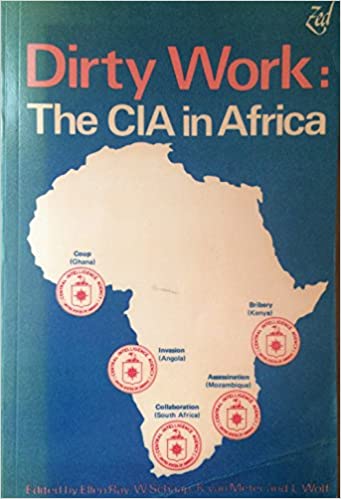
by Gerald Horne
+
MintPress
Study: NY Times, Washington Post Driving US to War with Russia Over Ukraine
https://www.mintpressnews.com/279612-2/279612/
by Alan Macleod
+
Eurasia
& the Epochal Decline in US Global Power
http://www.informationclearinghouse.info/56988.htm
by Alfred McCoy
+
Why
Peace Eludes U.S.-Russia Relations
http://www.informationclearinghouse.info/56983.htm
by Finian Cunningham
+
The
Year of the Tiger Starts With a Sino-Russian Bang
http://www.informationclearinghouse.info/56986.htm
by Pepe Escobar
+
A
war with Russia would be unlike anything the US and NATO have ever experienced

http://www.informationclearinghouse.info/56987.htm
by Scott Ritter
===========
f.
Leaked
Video Emerges Of US Stealth Jet Crashing On Carrier In South China Sea
by Tyler Durden
(00:51)
The
advanced F-35C stealth fighter was on approach to land on the USS Carl Vinson
as flight crews can be heard calling off the landing, but it was too late, as
the jet undershot the flight deck, causing its engine and tail to smack the
deck and miss the tailhook. The plane exploded into flames as it slid off the
carrier's flight deck into the South China Sea.
+
War In Northern Syria Is Gaining Momentum
https://www.zerohedge.com/markets/war-northern-syria-gaining-momentum
by SouthFront
(3:49)
+
Six
Russian Warships Enter Black Sea Ahead Of Large War Drills
by Tyler Durden
===========
g.
What
makes Amnesty’s apartheid report different?
https://electronicintifada.net/content/what-makes-amnestys-apartheid-report-different/34771
by Maureen Clare Murphy
+
Amnesty
joins others in accusing Israel of enforcing apartheid on Palestinians
http://www.informationclearinghouse.info/56981.htm
by Reuters
+
Gaza
farmers struggle for livelihoods and healthy soil
https://electronicintifada.net/content/gaza-farmers-struggle-livelihoods-and-healthy-soil/34756
by Yasmin Abusayma
+
Israel
executes three men in Nablus

https://electronicintifada.net/blogs/maureen-clare-murphy/israel-executes-three-men-nablus
by Maureen Clare Murphy
+
How
Israel’s Occupation of Palestine Intensifies Climate Change
https://www.mintpressnews.com/israels-occupation-palestine-intensifies-climate-change/279595/
by Jessica Buxbaum
+
Israel
Gets Georgia to Strip Free Speech Rights (Again)
with Abby Martin
(5:36)
+
Meet
the IDF-Linked Cybersecurity Group “Protecting” US Hospitals 'Pro Bono'

by Whitney Webb
+
Meet Ahmad
Mansour, the Palestinian doing Israel's dirty work in Germany
by Ali
Abunimah
===========
h.
Moral
panic at the disco! Comic books in the end times
https://therealnews.com/moral-panic-at-the-disco-comic-books-in-the-end-times
by Lyta Gold
(audio, 1:26:18)
===========
i.
Bret Baier: This is a big
problem for Justin Trudeau
https://www.youtube.com/watch?v=XEKJpauUXNo
(6:10)
+
ALL of Canada Has Joined The Convoy, Except Trudeau.
Accuses Freedom Convoy 2022 of Propagating Hatred, Racism and Violence
+
Video: Ottawa Freedom Convoy.
Justin Trudeau Accuses Them of "Violence" and "Racism". Why
All Those Lies?
+
Watch "Judge orders
‘no honking’ mandate; Freedom Convoy continues in Canada" on YouTube
+
Video: Freedom Convoy
Solidarity in Alberta. Agreement with RCMP
https://www.globalresearch.ca/video-freedom-convoy-solidarity-in-alberta-agreement-with-rcmp/5769858
+
Video:
Freedom Convoy Solidarity in Alberta. Agreement with RCMP
https://www.globalresearch.ca/video-freedom-convoy-solidarity-in-alberta-agreement-with-rcmp/5769858
by
+
Pfizer
Quietly Adds Language Warning That 'Unfavorable Pre-Clinical, Clinical Or
Safety Data' May Impact Business
by Tyler Durden
+
Alberta
To Scrap Vaccine Passport Program, Announces Path To Lifting 'Almost All'
Restrictions
by Tyler Durden
===========
j.
envoyé : 8 février 2022
de : News
from Underground <nobody@simplelists.com>
objet : Daily
digest for nfu@simplelists.com
|
1.On the "moon landing," and the urgency of (somehow)
exposing it as fake, at long last - Mark Crispin Miller (06
Feb 2022 19:02 EST) |
|
2.Take a look at Coutts, Alberta - Mark
Crispin Miller (06 Feb 2022 19:38 EST) |
|
3.The elite gathers its forces against the truckers - Mark
Crispin Miller (06 Feb 2022 20:56 EST) |
|
4.Where's
the outrage?? Joe Rogan has shot and killed triceratops, for SPORT! - Mark
Crispin Miller (07 Feb 2022 11:06 EST) |
|
5.The Great Purge of Medicine continues: Tom Cowan,
"conspiracy theory doctor," delicensed in California - Mark
Crispin Miller (07 Feb 2022 12:57 EST) |
1.On
the "moon landing," and the urgency of (somehow) exposing it as fake,
at long last by Mark
Crispin Miller (06 Feb 2022 19:02 EST)
Reply
to list
As we struggle to survive the
media's staggering Big Lies—for what we don't know certainly can hurt
us—I strongly recommend Sibrel's new book, Moon Man.
https://www.brighteon.com/765c8c5d-6783-4370-86cb-2b15721b1715
2.Take
a look at Coutts, Alberta by Mark
Crispin Miller (06 Feb 2022 19:38 EST)
Reply
to list
If only we were privy to the
globalists' discussion of what they might do to make this go away.
https://twitter.com/jccfcanada/status/1490422809176199174?s=27
3.The
elite gathers its forces against the truckers by Mark
Crispin Miller (06 Feb 2022 20:56 EST)
Reply
to list
The Elite Gathers Its Forces for a
Counterattack on the Truckers
February 6,
2022 | Categories: Articles
& Columns | Tags: | Print This Article
The
Elite Gathers Its Forces for a Counterattack on the Truckers
Paul
Craig Roberts
There
are reports that the Ottawa police, faithful servants, not of the people, but
of the ruling elite, are attempting to prevent food and water and all “material
support” from reaching the Truckers. In other words, the ruling elite is making
an effort to starve out the truckers.
Click on the link for the rest.
4.Where's
the outrage?? Joe Rogan has shot and killed triceratops, for SPORT! by Mark Crispin
Miller (07 Feb 2022 11:06 EST)
Reply
to list
5.The
Great Purge of Medicine continues: Tom Cowan, "conspiracy theory
doctor," delicensed in California by Mark
Crispin Miller (07 Feb 2022 12:57 EST)
Reply
to list
https://calmatters.org/health/2021/02/conspiracy-theory-doctor-surrenders-medical-license/
---
Support News from Underground: https://bit.ly/NFUSupport
Visit News from Underground: https://markcrispinmiller.com
For archives, please go to: https://archives.simplelists.com/nfu
===========
k.
Excess Deaths Point to Depopulation Agenda
https://www.globalresearch.ca/excess-deaths-point-depopulation-agenda/5761182I
by Mike
Whitney
+
If You Take the COVID Vax,
You Can Never Achieve Full Immunity Again – Government Stats Unveil the
Horrifying Truth
by Ethan
Huff
+
Vidéos of growing protests
against the vaccine that are censored in the corporate media.
https://www.bitchute.com/video/NvI4Er74uIqq/I
by
+
Police protest in Austria
against vaccine mandate.
from Juan F. Garcia
+
Top
News Archives - The Last American Vagabond

https://www.thelastamericanvagabond.com/category/top-news/
with Ryan Cristián
+
New
World Next Week with James Evan Pilato
https://www.corbettreport.com/nwnw20220203/
with James Corbett and James Evan Pilato
(29:43)
+
James
Corbett Redpills the Norwegians on the Global Conspiracy
with James Corbett
(1:05:23)
[Note: This conversation with Antijantepodden, one of the most popular podcasts in
the Norwegian language, was recorded on January
31, 2022 and intended for a mainstream audience who may be hearing this
information for the first time. For other examples of this "redpill
series," please follow this
link.]
+
February
Open Thread (2022) : The Corbett Report
https://www.corbettreport.com/openthreadfeb22/
with James Corbett
(3:08)
===========
l.
How
to Research Online
https://www.corbettreport.com/solutionswatch-research/
with James Corbett
(48:34)
+
Taibbi
Interviews Russell Brand, Who Isn't "Right Wing"
https://www.zerohedge.com/political/taibbi-interviews-russell-brand-who-isnt-right-wing
by Matt Taibbi
+
"Dismantling
Democracy" To Save It: How Democrats Rediscovered The Joys Of Rigging
Election
by Jonathan Turley
+
With
Alabama ruling, SCOTUS delivers 'Another major blow' to Voting Rights Act
https://therealnews.com/with-alabama-ruling-scotus-delivers-another-major-blow-to-voting-rights-act
by Jessica Corbett
===========
m.
From
Ukraine to Yemen, US arms industry reaps the spoils of war
https://thegrayzone.com/2022/01/28/from-ukraine-to-yemen-us-arms-industry-reaps-the-spoils-of-war/
by Aaron Maté
+
Propagandist
for Syria terror proxies compromised Amnesty International, leaked docs show
https://thegrayzone.com/2022/02/08/leaked-documents-syrian-terror-amnesty-international-syria/
by Kit Klarenberg
+
China’s
Belt Road Already Delivering for Southeast Asia
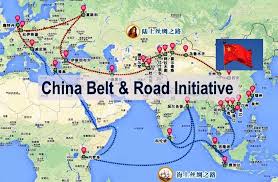
https://www.asia-pacificresearch.com/china-belt-road-already-delivering-southeast-asia/5630946
by Brian Berletic
===========
n.
J’Accuse! The Gene-based
Vaccines Are Killing People. Governments Worldwide Are Lying to You the People,
to the Populations They Purportedly Serve
+
The
Collapse of the COVID Narrative: A Brief Strategic Window to Regain Our
Democracies

by Elizabeth Woodworth
The COVID narrative is falling
apart,[i] and the great post-pandemic cover-up has begun.
+
The
2020-22 Worldwide Corona Crisis: Destroying Civil Society, Engineered Economic
Depression, Global Coup d'État and the "Great Reset"
by
Prof Michel Chossudovsky
+
This
Medical Data from the US Department of Defense Is Explosive – Mainstream Media
Has Been Ordered to Ignore It

https://www.globalresearch.ca/medical-data-us-dod-explosive-mainstream-media-ordered-ignore/5769754
by
Steve Kirsch
The original data :
Here are the resources with the original
data:
- Johnson’s 3 page letter to DoD Secretary Lloyd Austin
III
- Renz Law home
page (includes
video interviews)
- Renz Law page on the DMED data with graphs (summary of the
data)
- The Excel spreadsheet with all the numbers. Note that
the numbers in the purple coded rows are the “corrected” data which was
issued after the “glitch” was noticed. Hospitalized means the patient was
in the hospital. Ambulatory are the stats for outpatients. Also note that
the percentage calculation is wrong: they should have subtracted 1 since a
“2X increase” is the same as a “100% increase.”
+
Information
on Vacinne Codes and their taxicity.
https://www.bitchute.com/video/N7eOD86iyk01/
+
“A Guide to Home-Based COVID Treatment:
Step-By-Step Doctors’ Plan That Could Save Your Life”

https://aapsonline.org/CovidPatientTreatmentGuide.pdf
Edited by Jane M. Orient M.D. and
Elizabeth Lee Vliet, M.D.
(updated Feb. 2, 2022, 27 pages)
